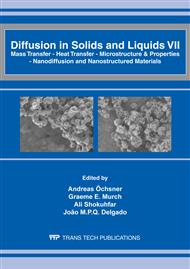p.372
p.377
p.383
p.388
p.394
p.400
p.405
p.410
p.416
Characterization of Pt-Doped WO3 Nanoparticles Synthesized by Flame Spray Pyrolysis
Abstract:
Undoped WO3 and WO3 nanoparticles doped with 0.251.0 wt.% Pt were successfully produced in a single step by flame spray pyrolysis (FSP) [. Tungsten (VI) ethoxide 5% w/v in ethanol 99.8% and platinum (II) acetylacetonate were used as W and Pt precursors respectively dissolved in ethanol. The undoped WO3 and Pt-doped WO3 nanoparticles were characterized by X-ray diffraction (XRD), scanning electron microscopy (SEM), transmission electron microscopy (TEM) and energy dispersive spectroscopy (EDS). The BET surface area (SSABET) of the nanoparticles was measured by nitrogen adsorption. From BET measurement, SSABET increased and dBET decreased with increasing Pt concentration from 0 to 1.0 wt.%. The morphology and accurate size of the primary particles were further investigated by high-resolution transmission electron microscopy (HRTEM). The crystallite size of undoped WO3 spherical was found to be ranging from 520 nm and the crystallite sizes of 0.251.0 wt.% Pt-doped WO3 spherical particles were found to be in the range of 520 nm.
Info:
Periodical:
Pages:
394-399
Citation:
Online since:
April 2012
Price:
Сopyright:
© 2012 Trans Tech Publications Ltd. All Rights Reserved
Share:
Citation:


